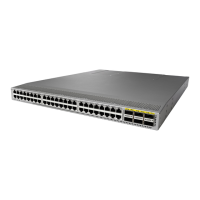Send document comments to nexus3k-docfeedback@cisco.com
9-3
Cisco Nexus 3000 Series NX-OS Unicast Routing Configuration Guide, NX-OS Release5.0(3)U1(1)
Chapter 9 Configuring Layer 3 Virtualization
Layer 3 Virtualization
VRF-Aware Services
A fundamental feature of the Cisco NX-OS architecture is that every IP-based feature is VRF aware.
The following VRF-aware services can select a particular VRF to reach a remote server or to filter
information based on the selected VRF:
• AAA—See the Cisco Nexus 3000 Series NX-OS Security Configuration Guide, for more
information.
• Call Home—See the Cisco Nexus 3000 Series NX-OS System Management Configuration Guide, for
more information.
• HSRP—See Chapter 12, “Configuring HSRP” for more information.
• HTTP—See the Cisco NX-OS Fundamentals Configuration Guide,, for more information.
• Licensing—See theCisco NX-OS Licensing Guide for more information.
• NTP—See the Cisco Nexus 3000 Series NX-OS System Management Configuration Guide, for more
information.
• RADIUS—See the Cisco Nexus 3000 Series NX-OS Security Configuration Guide, for more
information.
• Ping and Traceroute —See the Cisco NX-OS Fundamentals Configuration Guide,, for more
information.
• SSH—See the Cisco NX-OS Fundamentals Configuration Guide,, for more information.
• SNMP—See the Cisco Nexus 3000 Series NX-OS System Management Configuration Guide, for
more information.
• Syslog—See the Cisco Nexus 3000 Series NX-OS System Management Configuration Guide, for
more information.
• TACACS+—See the Cisco Nexus 3000 Series NX-OS Security Configuration Guide, for more
information.
• TFTP—See the Cisco NX-OS Fundamentals Configuration Guide,, for more information.
• VRRP—See Chapter 13, “Configuring VRRP” for more information.
See the appropriate configuration guide for each service for more information on configuring VRF
support in that service.
This section contains the following topics:
• Reachability, page 9-3
• Filtering, page 9-4
• Combining Reachability and Filtering, page 9-4
Reachability
Reachability indicates which VRF contains the routing information necessary to get to the server
providing the service. For example, you can configure an SNMP server that is reachable on the
management VRF. When you configure that server address on the router, you also configure which VRF
that Cisco NX-OS must use to reach the server.
Figure 9-2 shows an SNMP server that is reachable over the management VRF. You configure router A
to use the management VRF for SNMP server host 192.0.2.1.

